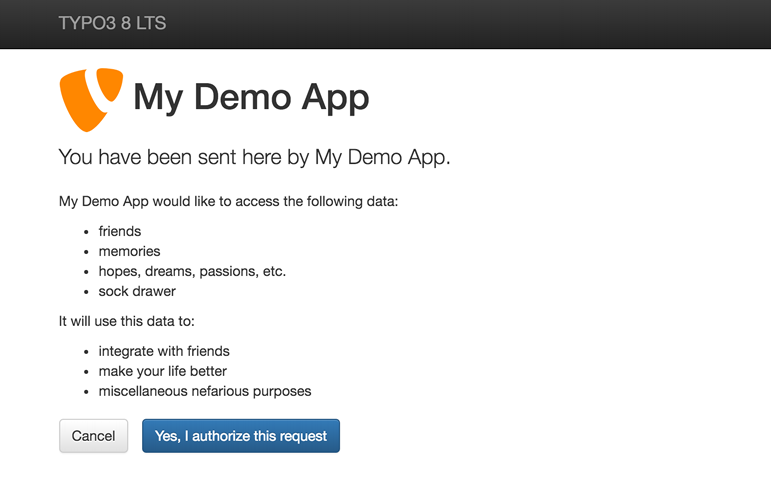This extension transforms your TYPO3 website into an OAuth2 server for any application you like.
It is based on the terrific OAuth2 PHP library written by Brent Shaffer.
Either install as usual from TER or manually by cloning the Git project:
$ cd /path/to/website/typo3conf/ext/ $ git clone https://github.com/xperseguers/t3ext-csl_oauth2.git csl_oauth2 $ cd csl_oauth2/Classes/ $ composer install
If you are using PHP fcgi, please add this to your :file:`.htaccess`:
RewriteEngine On
RewriteRule .* - [E=HTTP_AUTHORIZATION:%{HTTP:Authorization},L]Open TYPO3 module :menuselection:`Web --> List`, click on the root page of your TYPO3 install and create a new record of type "OAuth2 Client".
The general URL to use for the OAuth2 workflow is:
https://<www.typo3website-url.tld>/?eID=csl_oauth2&mode=<mode>&<additional-parameters>
where <mode> may be one of:
authorize: This starts the OAuth 2.0 authorization flow. This isn't really an API call — it's the web page that lets the user sign in to your TYPO3 website and authorize your app. After the user decides whether or not to authorize your app, they will be redirected to the URI specified byredirect_uri.token: This endpoint is sued to acquire a bearer token.
Important
Method to invoke the URL: GET.
OAuth 2.0 supports two authorization flows:
- The
codeflow returns a code via theredirect_uricallback which should then be converted into a bearer token using thetokenmode call. This is the recommended flow for apps that are running on a server. - The
tokenor implicit grant flow returns the bearer token via theredirect_uricallback, rather than requiring your app to make a second call to a server. This is useful for pure client-side apps, such as mobile apps or JavaScript-based apps.
For more information on the two flows, see Section 1.3 of the OAuth 2 spec.
| Parameter | Value |
|---|---|
| response_type | required The grant type requested, either token or `code. |
| client_id | required The app's key, found in your record's configuration. |
| redirect_uri | Where to redirect the user after authorization has completed. This must be the exact URI
registered in your record's configuration. A redirect URI is required for a token flow,
but optional for code. If the redirect URI is omitted, the code will be presented
directly to the user and they will be invited to enter the information in your app. |
| state | Up to 500 bytes of arbitrary data that will be passed back to your redirect URI. This parameters should be used to protect against cross-site request forgery (CSRF). See sections 4.4.1.8 and 4.4.2.5 of the OAuth 2.0 threat model spec. |
This will show an authorization form where the user will be able to authenticate and confirm she wants to authorize your client application to impersonate her on the TYPO3 website:
At the end of the process, your client application will be called back (using redirect_uri) with a JSON response.
Important
Method to invoke the URL: POST.
This endpoint only applies to apps using the authorization code flow. An app calls this endpoint to acquire a bearer token once the user has authorized the app.
Calls to token need to be authenticated using the apps's key and secret. These can either be passed as POST
parameters (see parameters below) or via
HTTP basic authentication. If basic authentication is used,
the app key should be provided as the username, and the app secret should be provided as the password.
| Parameter | Value |
|---|---|
| code | required The code acquired by directing users to &mode=authorize&response_type=code. |
| grant_type | required The grant type, which must be authorization_code. |
| client_id | If credentials are passed in POST parameters, this parameter should be present and should be the app's key, found in your record's configuration. |
| client_secret | If credentials are passed in POST parameters, this parameter should be present and should be the app's secret, found in your record's configuration. |
| redirect_uri | Only used to validate that it matches the original value in &mode=authorize, not used to redirect
again. |
This returns a JSON-encoded dictionary including an access token (access_token), token type (token_type), user ID (uid). The token type will always be "bearer".
